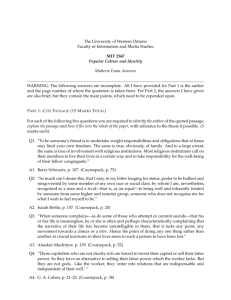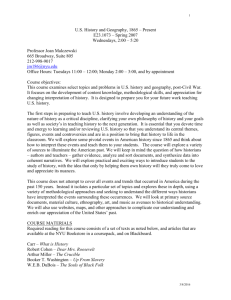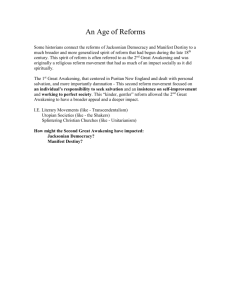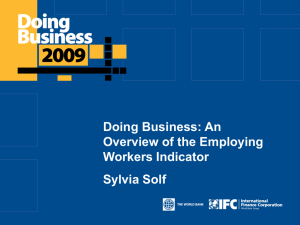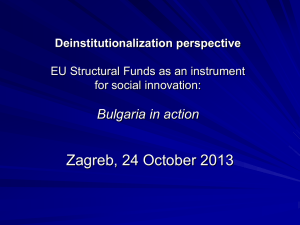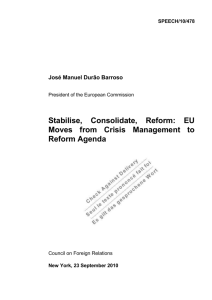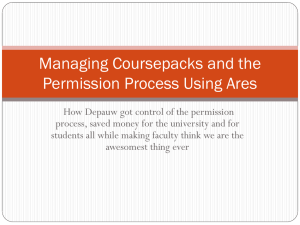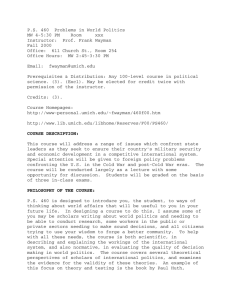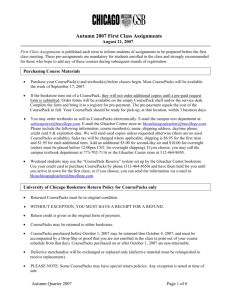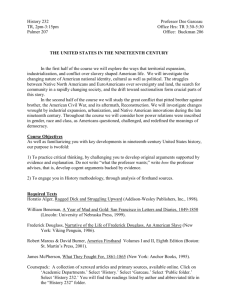Department of Economics
advertisement
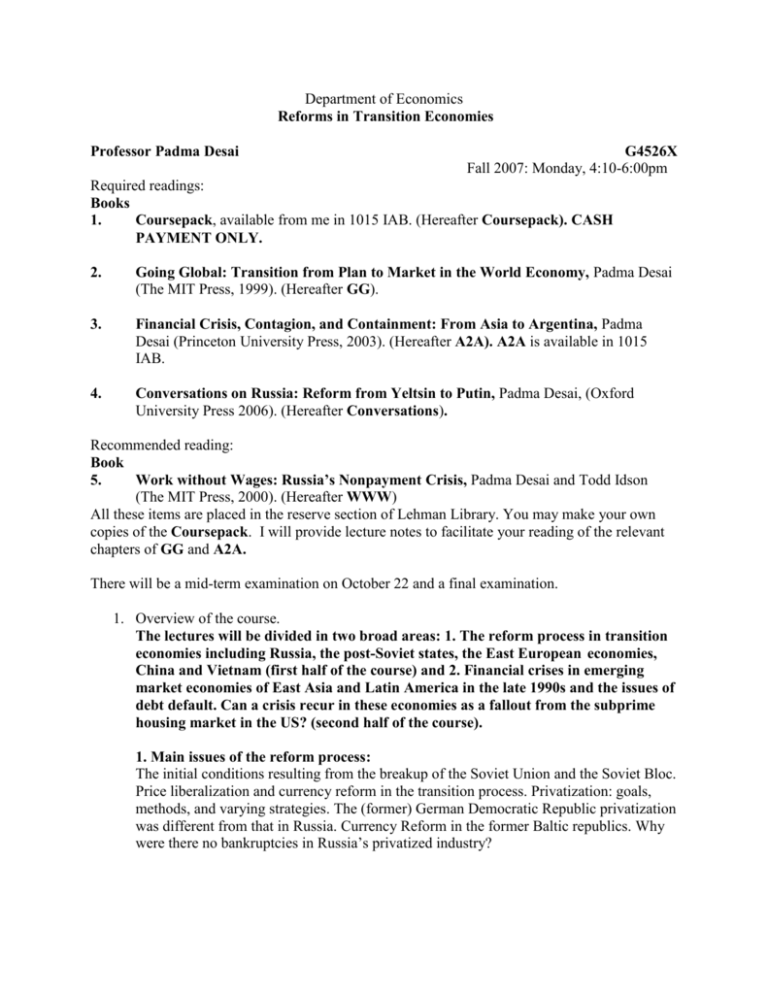
Department of Economics Reforms in Transition Economies Professor Padma Desai G4526X Fall 2007: Monday, 4:10-6:00pm Required readings: Books 1. Coursepack, available from me in 1015 IAB. (Hereafter Coursepack). CASH PAYMENT ONLY. 2. Going Global: Transition from Plan to Market in the World Economy, Padma Desai (The MIT Press, 1999). (Hereafter GG). 3. Financial Crisis, Contagion, and Containment: From Asia to Argentina, Padma Desai (Princeton University Press, 2003). (Hereafter A2A). A2A is available in 1015 IAB. 4. Conversations on Russia: Reform from Yeltsin to Putin, Padma Desai, (Oxford University Press 2006). (Hereafter Conversations). Recommended reading: Book 5. Work without Wages: Russia’s Nonpayment Crisis, Padma Desai and Todd Idson (The MIT Press, 2000). (Hereafter WWW) All these items are placed in the reserve section of Lehman Library. You may make your own copies of the Coursepack. I will provide lecture notes to facilitate your reading of the relevant chapters of GG and A2A. There will be a mid-term examination on October 22 and a final examination. 1. Overview of the course. The lectures will be divided in two broad areas: 1. The reform process in transition economies including Russia, the post-Soviet states, the East European economies, China and Vietnam (first half of the course) and 2. Financial crises in emerging market economies of East Asia and Latin America in the late 1990s and the issues of debt default. Can a crisis recur in these economies as a fallout from the subprime housing market in the US? (second half of the course). 1. Main issues of the reform process: The initial conditions resulting from the breakup of the Soviet Union and the Soviet Bloc. Price liberalization and currency reform in the transition process. Privatization: goals, methods, and varying strategies. The (former) German Democratic Republic privatization was different from that in Russia. Currency Reform in the former Baltic republics. Why were there no bankruptcies in Russia’s privatized industry? 2 Distinction between macroeconomic stabilization and structural reforms. Lack of fiscal discipline, budget deficit and revenue shortfall in the budget sector during Yeltsin reforms (1992-1999). Why did the ruble collapse in August 1998? Implications of the continuing strong Russian budgetary and macroeconomic performance since 2000. Currency convertibility. Fixed versus flexible exchange rates. Exchange-rate based stabilization in Russia, Poland, Hungary, and the Czech Republic. Shock therapy versus gradualism. Is faster reform necessarily better? The social costs of big bang reforms and reform sustainability. Contrasting reforms in transition economies. Contrast the reform process in Poland, the Czech Republic, the Baltic States and Vietnam with the process in Russia, Uzbekistan, Kazakhstan, China, and Hungary. The recent issues of the accession of the Baltic states and several East European countries into the European Union. How can they qualify to become members of the European Monetary Union? 2. Financial crises origin, contagion and containment: Double mismatch in the borrowing activity of emerging market economies. IMF rescue packages and policies. Financial architecture reform. Do the recent capital inflows and the US subprime housing market problems threaten emerging market economies with a replay of the East Asian financial crisis of 1997-1999? (Lecture 1, 9-10) 2. The pre-reform background in Russia: the role of the Gorbachev phase of breath-taking political liberalization and economic failings. Why did the Soviet Union fall apart? From microeconomic inefficiency to macroeconomic disequilibrium: the Soviet record of growth retardation with fixed prices followed by macroeconomic mismanagement with pell-mell price reform under Gorbachev. Administered prices, repressed inflation, ruble overhang and microeconomic inefficiency. Localized versus generalized shortages. (Coursepack, pp. 1-48) (Lecture 2, 9-17). 3. Price liberalization. The price level and relative prices. What is an ideal price reform? Should all prices be freed at once? Why not? The problem of monopolies. Russian price reform: what problems did it encounter? The relevance of monetary control and currency reform in the price liberalization process. Various types of currency reforms including in the former German Democratic Republic and the former Baltic republics. What are the issues? (Coursepack, pp. 49-82) (GG, ch. 5, pp. 243-260; The Baltic States; The former German Democratic Republic, GG, ch. 3, pp 177-180) (Lecture 3, 9-24). 4. Privatization issues and methods. Distinction between securitization, commercialization and privatization. The goals of efficiency versus fairness. Voucher privatization. East European privatization experience in Poland, Hungary, the Czech Republic and the (former) German Democratic Republic. Loans for shares and the emergence of the oligarchs. The results of Russian privatization. The social costs. Barter and nonpayment in lieu of enterprise restructuring. Where were the bankruptcies? (Coursepack, pp. 83- 3 137; Conversations, 2) (GG, ch. 3, The former German Democratic Republic) (Lecture 4, 10-1). 5. Definition and measures of budget deficit. The problems of raising taxes in Russia. The budgetary cutbacks and military disintegration. The off-budget pension fund and its problems. (Coursepack, pp. 138-148; WWW, chs. 6, 7; Conversations, chs. 11 and 12) (Lecture 5, 10-8). 6. Recent Russian recovery and emergence of budget surpluses. Analytical issues of YUKOS. Where is Putin heading? The tradeoff between advancing economic reforms and tightening political measures (Coursepack, pp. 149-195; Conversations, Introduction and chs. 1, 3, 4, 5, 6, 14 and 16) (Lecture 6, 10-15). Mid-term examination (10-22). 7. Currency convertibility and trade liberalization. Different types of exchange rate regimes. The concepts of nominal and real exchange rates. Fixed versus flexible exchange rate models. The concept of purchasing power parity. Macroeconomic stabilization via exchange rate manipulation. The conflict between inflation control and trade competitiveness. (Coursepack, pp. 196-204) (Lecture 7, 10-29). 8. Transition experiences of different countries. The East-Central European Economies, the Baltic States, Kazakhstan, Uzbekistan, Vietnam and China (GG, pp. 97-272; pp. 353-471; omit pp. 123-134, 193-198, Section 3.3.2, 273-351, 397-412, 473-496. PLEASE COMBINE YOUR READING OF THE GG CHAPTERS WITH THE RELEVANT SUMMARIES OF THESE PAGES IN THE COURSEPACK, PP. 205-214) (Lecture 8, 11-12). 9. Shock therapy versus gradualism: the debates. Is quicker reform better in terms of growth turnaround, inflation control, private foreign investment, globalization and employment creation? The problem of reform sustainability (GG, pp. 1-94; Coursepack, pp 215- 245) (Lecture 9, 11-19). 10. Reasons for the East Asian financial crisis. Premature capital mobility. Why did the ruble collapse? Contagion from Asia to Brazil via Russia. The later crisis in Turkey and Argentina . Will Lula make it in Brazil? Turkey: The sick man of Europe. Argentina’s debt default. (A2A, pp. 86-161; pp. 163-211; Coursepack, pp. 246-251) (Lecture 10, 11-26). 11. IMF rescue packages. Financial architecture reforms (A2A, pp. 212-241; A2A, pp. 263283; Coursepack, pp. 252-286). (Lecture 11, 12-3). 12. Financial flows, exchange rate movements and crisis recurrence scenarios (Coursepack, pp. 287-308). (Lecture 12, 12-10). 14. Examination (12-???). 4
